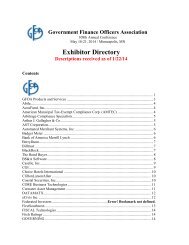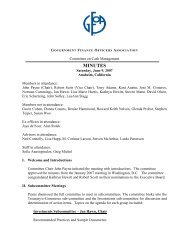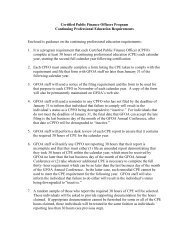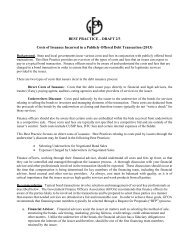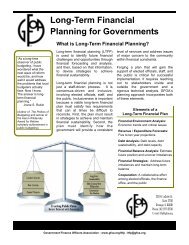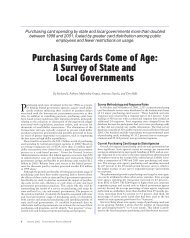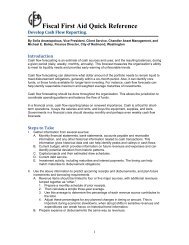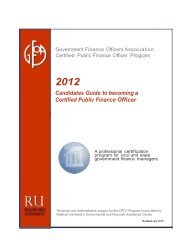Guidelines for the Effective Use of Swaps in Asset-Liability ...
Guidelines for the Effective Use of Swaps in Asset-Liability ...
Guidelines for the Effective Use of Swaps in Asset-Liability ...
You also want an ePaper? Increase the reach of your titles
YUMPU automatically turns print PDFs into web optimized ePapers that Google loves.
Editor’s note: This article is repr<strong>in</strong>ted with <strong>the</strong> permission <strong>of</strong> Fitch Rat<strong>in</strong>gs.<br />
The views expressed here<strong>in</strong> are <strong>the</strong> authors’ and do not represent <strong>the</strong> <strong>of</strong>ficial<br />
position <strong>of</strong> GFOA or its stand<strong>in</strong>g committees.<br />
The ongo<strong>in</strong>g decl<strong>in</strong>e <strong>of</strong> <strong>in</strong>terest rates has presented creditworthy<br />
borrowers with exceptional f<strong>in</strong>anc<strong>in</strong>g opportunities.<br />
In this low <strong>in</strong>terest rate environment, many borrowers have<br />
reduced <strong>the</strong>ir debt service costs by refund<strong>in</strong>g outstand<strong>in</strong>g debt and<br />
have f<strong>in</strong>anced new projects at very low costs. Lower debt service<br />
costs have also provided some budget relief. Simultaneously, low<br />
<strong>in</strong>terest rates have affected returns on <strong>in</strong>vestments. The impact on<br />
tax-exempt borrowers with sizeable<br />
funds restricted to short-term fixed<strong>in</strong>come<br />
<strong>in</strong>vestments has been especially<br />
severe, as <strong>the</strong>y repeatedly<br />
re<strong>in</strong>vest matur<strong>in</strong>g pr<strong>in</strong>cipal at everlower<br />
rates.<br />
Responses to <strong>the</strong> mixed bless<strong>in</strong>gs<br />
<strong>of</strong> <strong>the</strong> low <strong>in</strong>terest rate environment<br />
have varied among taxexempt<br />
borrowers and have to<br />
some extent depended on <strong>the</strong>ir<br />
management structure. Those that<br />
manage <strong>in</strong>vestments and liabilities<br />
separately may adjust only <strong>the</strong>ir<br />
<strong>in</strong>vestment policy without chang<strong>in</strong>g<br />
<strong>the</strong>ir debt policy or vice versa.<br />
These borrowers may also adjust<br />
both <strong>the</strong>ir debt and <strong>the</strong>ir <strong>in</strong>vestment<br />
policies — but <strong>in</strong> isolation.<br />
Alternatively, <strong>in</strong> recognition <strong>of</strong><br />
<strong>the</strong> potentially <strong>of</strong>fsett<strong>in</strong>g impact <strong>of</strong><br />
<strong>in</strong>terest rate fluctuations on certa<strong>in</strong><br />
assets and liabilities, some taxexempt<br />
borrowers are adopt<strong>in</strong>g<br />
comprehensive asset and liability<br />
management policies. Such policies, which are more prevalent <strong>in</strong><br />
corporate f<strong>in</strong>ance, <strong>in</strong>corporate coord<strong>in</strong>ated <strong>in</strong>vestment and debt<br />
structur<strong>in</strong>g decisions. The goal <strong>of</strong> such coord<strong>in</strong>ation is to use each<br />
side <strong>of</strong> <strong>the</strong> balance sheet to mitigate, or hedge, cash flow risks posed<br />
by <strong>the</strong> o<strong>the</strong>r side <strong>of</strong> <strong>the</strong> balance sheet.<br />
Ei<strong>the</strong>r as part <strong>of</strong> or separate from asset and liability management<br />
strategies, <strong>in</strong>creas<strong>in</strong>g numbers <strong>of</strong> tax-exempt borrowers have used<br />
<strong>in</strong>terest rate swaps to hedge <strong>the</strong>ir exposure to <strong>in</strong>terest rate fluctuations.<br />
They have used swaps to <strong>in</strong>crease exposure to variable-rate<br />
debt through fixed-to-float<strong>in</strong>g <strong>in</strong>terest rate swaps and have hedged<br />
<strong>Guidel<strong>in</strong>es</strong><br />
<strong>for</strong> <strong>Effective</strong> <strong>Use</strong>s<br />
<strong>of</strong> <strong>Swaps</strong><br />
<strong>in</strong> <strong>Asset</strong>-<strong>Liability</strong><br />
Management<br />
By Ka<strong>the</strong>r<strong>in</strong>e McManus, Karl Pfeil, and Trudy Zibit<br />
<strong>the</strong>ir exposure to variable <strong>in</strong>terest rates through float<strong>in</strong>g-to-fixed<br />
rate swaps. Although <strong>the</strong> current trend <strong>of</strong> <strong>in</strong>creased use <strong>of</strong> <strong>in</strong>terest<br />
rate swaps has developed dur<strong>in</strong>g a period <strong>of</strong> decl<strong>in</strong><strong>in</strong>g <strong>in</strong>terest<br />
rates, <strong>the</strong> use <strong>of</strong> <strong>in</strong>terest rate swaps and o<strong>the</strong>r <strong>in</strong>terest rate hedg<strong>in</strong>g<br />
products, such as caps and collars, is expected to cont<strong>in</strong>ue even if<br />
<strong>the</strong> <strong>in</strong>terest rate environment changes, as <strong>the</strong>se products provide<br />
tax-exempt borrowers with f<strong>in</strong>ancial flexibility not <strong>of</strong>fered by traditional<br />
f<strong>in</strong>anc<strong>in</strong>g methods.<br />
Fitch Rat<strong>in</strong>gs recognizes that, when used <strong>in</strong> <strong>the</strong> context <strong>of</strong> comprehensive<br />
asset and liability management strategies, variable-rate<br />
debt and <strong>in</strong>terest rate hedges can enhance <strong>the</strong> f<strong>in</strong>ances <strong>of</strong> some<br />
tax-exempt borrowers. However,<br />
when used without a coherent<br />
strategy or by borrowers with<br />
f<strong>in</strong>ances that are already vulnerable,<br />
such f<strong>in</strong>ancial products can<br />
result <strong>in</strong> adverse credit consequences.<br />
Fur<strong>the</strong>rmore, because<br />
many municipal swap features<br />
are both unique and relatively<br />
new, borrowers should consider<br />
carefully all assumptions underly<strong>in</strong>g<br />
risk calculations.<br />
The guidel<strong>in</strong>es <strong>in</strong> this report are<br />
<strong>in</strong>tended to <strong>in</strong><strong>for</strong>m municipal<br />
market participants <strong>of</strong> <strong>the</strong> factors<br />
that Fitch considers when analyz<strong>in</strong>g<br />
<strong>the</strong> impact <strong>of</strong> variable-rate<br />
debt and <strong>in</strong>terest rate swaps on<br />
debt issuer credit. Fitch f<strong>in</strong>ds that,<br />
while a number <strong>of</strong> elements may<br />
<strong>in</strong>fluence <strong>the</strong> credit impact <strong>of</strong> variable-rate<br />
debt and <strong>in</strong>terest rate<br />
hedg<strong>in</strong>g products, <strong>the</strong> overall<br />
management framework is <strong>the</strong><br />
most relevant <strong>in</strong>dicator <strong>of</strong> future<br />
credit impact. There<strong>for</strong>e, Fitch<br />
considers borrowers’ policies and procedures <strong>for</strong> manag<strong>in</strong>g <strong>the</strong><br />
benefits and risks <strong>of</strong> selected debt structures, <strong>in</strong>vestments, and any<br />
related <strong>in</strong>terest rate hedg<strong>in</strong>g products (asset and liability management<br />
policies). Fitch also considers <strong>the</strong> application <strong>of</strong> asset and liability<br />
management policies, <strong>in</strong>clud<strong>in</strong>g overall debt structure and<br />
asset pr<strong>of</strong>ile, future capital needs, consideration <strong>of</strong> alternative<br />
structures, and reason<strong>in</strong>g <strong>in</strong> support <strong>of</strong> selections, as well as <strong>the</strong><br />
likelihood <strong>of</strong> achiev<strong>in</strong>g <strong>the</strong> goals <strong>of</strong> <strong>the</strong> adopted policies.<br />
When borrowers use <strong>in</strong>terest rate swaps to create or mitigate<br />
exposure to variable <strong>in</strong>terest rates, Fitch focuses on <strong>the</strong> follow<strong>in</strong>g<br />
June 2003 | Government F<strong>in</strong>ance Review 35
aspects <strong>of</strong> swap transactions: priority <strong>of</strong> swap payments; basis risk;<br />
term<strong>in</strong>ation provisions; and counterparty credit risk. Fitch also<br />
considers borrowers’ disclosure policies.<br />
ASSET AND LIABILITY MANAGEMENT POLICIES<br />
Adoption <strong>of</strong> comprehensive asset and liability management<br />
strategies will <strong>in</strong>crease a borrower’s chances to maximize <strong>the</strong><br />
benefits and m<strong>in</strong>imize <strong>the</strong> risks <strong>of</strong> variable-rate debt and <strong>in</strong>terest<br />
rate hedg<strong>in</strong>g <strong>in</strong>struments. In Fitch’s view, comprehensive policies<br />
<strong>in</strong>clude <strong>the</strong> follow<strong>in</strong>g:<br />
■ Identification <strong>of</strong> <strong>in</strong>vestment objectives, <strong>in</strong>clud<strong>in</strong>g target asset<br />
allocations, expected <strong>in</strong>vestment returns, and, <strong>for</strong> fixed-<strong>in</strong>come<br />
<strong>in</strong>vestments, a breakdown <strong>of</strong> short- and long-term <strong>in</strong>vestments<br />
■ Investment time horizons<br />
■ Identification <strong>of</strong> debt, <strong>in</strong>vestment management products, derivatives,<br />
and counterparty rat<strong>in</strong>gs acceptable to <strong>the</strong> debt issuer<br />
■ Forecasts <strong>of</strong> <strong>in</strong>terest rate volatility over <strong>the</strong> short and long terms<br />
and expected per<strong>for</strong>mance <strong>of</strong> selected f<strong>in</strong>ancial products<br />
under various <strong>in</strong>terest rate scenarios<br />
■ Strategies <strong>for</strong> respond<strong>in</strong>g to changes <strong>in</strong> short- and long-term<br />
<strong>in</strong>terest rates<br />
■ Designation <strong>of</strong> <strong>in</strong>dividuals responsible <strong>for</strong> negotiat<strong>in</strong>g f<strong>in</strong>ancial<br />
products and coord<strong>in</strong>at<strong>in</strong>g <strong>in</strong>vestment and debt structur<strong>in</strong>g<br />
decisions<br />
■ Designation <strong>of</strong> <strong>in</strong>dividuals responsible <strong>for</strong> monitor<strong>in</strong>g and<br />
report<strong>in</strong>g on market conditions and <strong>the</strong>ir impact on per<strong>for</strong>mance<br />
<strong>of</strong> debt, <strong>in</strong>vestments, and any <strong>in</strong>terest rate hedg<strong>in</strong>g products<br />
under consideration or already implemented<br />
■ Frequency and method <strong>of</strong> mark<strong>in</strong>g-to-market and monitor<strong>in</strong>g<br />
<strong>in</strong>vestments and o<strong>the</strong>r f<strong>in</strong>ancial products<br />
■ Sources and liquidity <strong>of</strong> funds available <strong>for</strong> potential swap<br />
term<strong>in</strong>ation payments<br />
■ Creation <strong>of</strong> hedge reserve funds<br />
Although Fitch views adoption <strong>of</strong> comprehensive asset and liability<br />
management policies as a best management practice, Fitch<br />
also recognizes that many tax-exempt borrowers have not yet<br />
adopted a s<strong>in</strong>gle comprehensive policy <strong>in</strong>corporat<strong>in</strong>g all <strong>of</strong> <strong>the</strong> elements<br />
listed above. Thus, if borrowers do not take such a comprehensive<br />
approach, Fitch evaluates <strong>the</strong> credit impact <strong>of</strong> variable-rate<br />
debt and <strong>in</strong>terest rate hedg<strong>in</strong>g products <strong>in</strong> light <strong>of</strong> each debt issuer’s<br />
asset allocation and <strong>in</strong>vestment policies, as expla<strong>in</strong>ed below.<br />
Application <strong>of</strong> <strong>Asset</strong> and <strong>Liability</strong> Management Policies.<br />
Adoption <strong>of</strong> a comprehensive asset and liability management policy<br />
is an important first step <strong>for</strong> tax-exempt borrowers <strong>in</strong>curr<strong>in</strong>g variable-rate<br />
debt and/or utiliz<strong>in</strong>g <strong>in</strong>terest rate hedg<strong>in</strong>g products. In<br />
addition to evaluat<strong>in</strong>g <strong>the</strong> contents <strong>of</strong> such plans, Fitch considers<br />
whe<strong>the</strong>r <strong>the</strong> debt structure <strong>in</strong>corporated <strong>in</strong>to <strong>the</strong> plan is appropriate<br />
<strong>for</strong> particular borrowers. General bond market conditions, sources<br />
and costs <strong>of</strong> <strong>in</strong>ternal or external liquidity, natural and syn<strong>the</strong>tic <strong>in</strong>terest<br />
rate hedges, prior experience manag<strong>in</strong>g <strong>in</strong>terest rate risk, and<br />
marg<strong>in</strong>s <strong>for</strong> tolerat<strong>in</strong>g <strong>in</strong>creases <strong>in</strong> <strong>in</strong>terest rates are factors <strong>in</strong> mak<strong>in</strong>g<br />
such a determ<strong>in</strong>ation.<br />
Given that such factors vary <strong>for</strong> each tax-exempt issuer, Fitch<br />
does not recommend universal ratios <strong>of</strong> net variable-rate debt to<br />
total capitalization (total debt plus equity). However, Fitch does<br />
recognize common credit characteristics among borrowers <strong>for</strong><br />
which issuance <strong>of</strong> higher proportions <strong>of</strong> variable-rate debt is appropriate.<br />
Such borrowers have strong, predictable cash flows and<br />
<strong>in</strong>ternal liquidity sufficient to absorb fluctuations <strong>in</strong> <strong>in</strong>terest rates,<br />
characteristics that also correlate strongly with high <strong>in</strong>vestmentgrade<br />
credit rat<strong>in</strong>gs. These borrowers are generally sophisticated<br />
and experienced <strong>in</strong> debt markets — fur<strong>the</strong>r <strong>in</strong>dicators <strong>of</strong> ability to<br />
assume percentages <strong>of</strong> variable-rate debt relatively greater than <strong>the</strong><br />
percentages manageable <strong>for</strong> lower rated borrowers.<br />
Fur<strong>the</strong>rmore, <strong>in</strong> evaluat<strong>in</strong>g borrowers’ exposure to variable <strong>in</strong>terest<br />
rates, Fitch focuses on net, ra<strong>the</strong>r than gross, variable-rate debt.<br />
This calculation subtracts from total (or gross) variable-rate debt<br />
amounts that are effectively hedged, ei<strong>the</strong>r with <strong>for</strong>ms <strong>of</strong> self-liquidity,<br />
<strong>in</strong>clud<strong>in</strong>g certa<strong>in</strong> short-term <strong>in</strong>vestments, or with <strong>in</strong>terest rate swaps<br />
meet<strong>in</strong>g <strong>the</strong> standards outl<strong>in</strong>ed <strong>in</strong> <strong>the</strong> Interest Rate <strong>Swaps</strong> section.<br />
Fitch considers short-term <strong>in</strong>vestments effective hedges to variable-rate<br />
debt because movements <strong>in</strong> <strong>in</strong>terest rates should have<br />
<strong>of</strong>fsett<strong>in</strong>g impacts on both. If <strong>in</strong>terest rates rema<strong>in</strong> low, decreased<br />
<strong>in</strong>vestment returns should be <strong>of</strong>fset by lower debt service costs.<br />
Conversely, if short-term <strong>in</strong>terest rates rise, higher debt service<br />
costs should be mitigated by higher <strong>in</strong>vestment returns.<br />
Strategy Execution. Fitch’s expectation <strong>of</strong> successfully executed<br />
asset and liability management strategies is <strong>in</strong>fluenced by<br />
<strong>the</strong> debt issuer’s experience <strong>in</strong> <strong>the</strong> f<strong>in</strong>ancial markets and prior successful<br />
use <strong>of</strong> <strong>in</strong>novative f<strong>in</strong>anc<strong>in</strong>g tools. Inexperience may, however,<br />
be mitigated by longstand<strong>in</strong>g relationships with experienced<br />
f<strong>in</strong>ancial pr<strong>of</strong>essionals charged with select<strong>in</strong>g and monitor<strong>in</strong>g <strong>the</strong><br />
per<strong>for</strong>mance <strong>of</strong> f<strong>in</strong>anc<strong>in</strong>g and <strong>in</strong>vestment products.<br />
In addition, borrowers demonstrat<strong>in</strong>g an understand<strong>in</strong>g <strong>of</strong> <strong>the</strong><br />
benefits and risks associated with <strong>the</strong> selected debt structure and<br />
related f<strong>in</strong>ancial products are more likely to realize <strong>the</strong>ir benefits.<br />
There<strong>for</strong>e, Fitch reviews and discusses with borrowers <strong>the</strong> follow<strong>in</strong>g:<br />
■ Debt structure and f<strong>in</strong>ancial products selected<br />
■ Alternatives that may have been considered<br />
36 Government F<strong>in</strong>ance Review | June 2003
■ Reasons <strong>for</strong> select<strong>in</strong>g or accept<strong>in</strong>g certa<strong>in</strong> provisions<br />
<strong>of</strong> swap documents<br />
■ Suitability <strong>of</strong> debt structure and selected <strong>in</strong>terest rate hedg<strong>in</strong>g<br />
products <strong>in</strong> light <strong>of</strong> <strong>the</strong> issuer’s policies<br />
Suitability <strong>of</strong> debt structure also depends on <strong>the</strong> nature <strong>of</strong> a debt<br />
issuer’s revenues. For example, borrowers with economically sensitive<br />
revenue streams, such as tolls, may reasonably expect that<br />
<strong>the</strong>ir revenues would <strong>in</strong>crease dur<strong>in</strong>g periods <strong>of</strong> <strong>in</strong>creased economic<br />
activity. Increased revenues would be expected to result<br />
from both higher traffic levels and decreased resistance to higher<br />
toll rates, which could <strong>the</strong>n <strong>of</strong>fset <strong>the</strong> higher variable <strong>in</strong>terest rates<br />
that are also likely dur<strong>in</strong>g such periods. In contrast, borrowers with<br />
<strong>in</strong>flexible revenue streams or revenues that are not l<strong>in</strong>ked to general<br />
economic activity may be unable to <strong>of</strong>fset <strong>the</strong> consequences<br />
<strong>of</strong> higher <strong>in</strong>terest rates.<br />
INTEREST RATE SWAPS<br />
Tax-exempt borrowers have been utiliz<strong>in</strong>g <strong>in</strong>terest rate swaps<br />
with <strong>in</strong>creas<strong>in</strong>g frequency. Float<strong>in</strong>g- to fixed-rate swaps have been<br />
used to hedge <strong>in</strong>terest rate risk on variable-rate demand obligations,<br />
or VRDOs; lock <strong>in</strong> fixed <strong>in</strong>terest rates on refund<strong>in</strong>g bonds that will<br />
be issued <strong>in</strong> <strong>the</strong> future; or take advantage <strong>of</strong> opportunities to obta<strong>in</strong><br />
fixed swap rates that are lower than comparable fixed bond rates.<br />
O<strong>the</strong>r tax-exempt borrowers have created syn<strong>the</strong>tic float<strong>in</strong>g-rate<br />
debt with fixed- to float<strong>in</strong>g-rate swaps. Such borrowers may receive<br />
<strong>the</strong> benefits <strong>of</strong> lower float<strong>in</strong>g <strong>in</strong>terest rates without <strong>in</strong>curr<strong>in</strong>g <strong>the</strong><br />
remarket<strong>in</strong>g and liquidity costs associated with variable-rate<br />
demand bonds. In addition, borrowers, <strong>in</strong>clud<strong>in</strong>g some hospitals,<br />
encounter<strong>in</strong>g barriers to obta<strong>in</strong><strong>in</strong>g ei<strong>the</strong>r <strong>the</strong> liquidity support necessary<br />
to market VRDOs or <strong>the</strong> bond <strong>in</strong>surance preferred <strong>for</strong> market<strong>in</strong>g<br />
auction-rate securities, have also utilized fixed- to float<strong>in</strong>g-rate<br />
swaps.<br />
Fitch considers <strong>the</strong> impact <strong>of</strong> <strong>in</strong>terest rate swaps <strong>in</strong> light <strong>of</strong> borrowers’<br />
overall asset and liability management policies. Review by<br />
Fitch <strong>of</strong> <strong>in</strong>dividual swap documents may be less likely when such<br />
policies <strong>in</strong>clude detailed parameters <strong>for</strong> acceptable swap<br />
providers and provisions. In those cases, Fitch may rely on <strong>the</strong><br />
policies and management’s commitment to adhere to <strong>the</strong>m.<br />
However, when borrowers execute swaps without a comprehensive<br />
policy, Fitch may determ<strong>in</strong>e that a review <strong>of</strong> swap documents,<br />
<strong>in</strong>clud<strong>in</strong>g master agreements, schedules, and confirmations, is<br />
warranted. In ei<strong>the</strong>r case, Fitch focuses on <strong>the</strong> aspects <strong>of</strong> <strong>in</strong>terest<br />
rate swaps described below.<br />
Priority <strong>of</strong> Swap Payments. Net <strong>in</strong>terest payments on swaps<br />
by tax-exempt borrowers <strong>of</strong>ten rank on parity with debt service<br />
under related bond documents. Fitch believes that such rank<strong>in</strong>g<br />
alone generally should not affect bondholder credit adversely. In<br />
addition, when Fitch is <strong>in</strong><strong>for</strong>med <strong>of</strong> swap agreements, <strong>the</strong> net<br />
impact <strong>of</strong> <strong>the</strong> issuer’s obligations under such agreements is reflected<br />
<strong>in</strong> Fitch’s rat<strong>in</strong>g. For example, debt service coverage calculations<br />
may be based on actual <strong>in</strong>terest payments made after add<strong>in</strong>g<br />
or subtract<strong>in</strong>g payments made by or to <strong>the</strong> debt issuer under related<br />
swap agreements.<br />
Borrowers and <strong>in</strong>vestors should, however, consider all potential<br />
consequences <strong>of</strong> rank<strong>in</strong>g net <strong>in</strong>terest payments on parity to<br />
senior debt. For example, failure by <strong>the</strong> debt issuer to make net<br />
swap payments may cause a default on bonds that are related<br />
and/or unrelated to <strong>the</strong> swap. Also, when swap payments are<br />
ranked on parity to senior debt, liquidity facilities support<strong>in</strong>g<br />
VRDOs may be subject to automatic term<strong>in</strong>ation follow<strong>in</strong>g a payment<br />
default on <strong>the</strong> swap. Previously, def<strong>in</strong>itions <strong>of</strong> senior debt <strong>in</strong><br />
liquidity facilities <strong>in</strong>cluded only publicly issued bonds or notes<br />
and did not <strong>in</strong>clude <strong>the</strong> debt issuer’s contractual obligations,<br />
such as <strong>in</strong>terest rate swaps. As long as debt issuer account<strong>in</strong>g systems<br />
treat net <strong>in</strong>terest payments under swaps and debt payments<br />
identically, bondholders should <strong>in</strong>cur no additional risk from this<br />
expanded def<strong>in</strong>ition <strong>of</strong> parity debt. However, <strong>in</strong>vestors should be<br />
aware <strong>of</strong> this development.<br />
In contrast, Fitch supports cont<strong>in</strong>ued rank<strong>in</strong>g <strong>of</strong> term<strong>in</strong>ation<br />
payments below debt service obligations. This <strong>in</strong>dustry standard<br />
ensures that debt service payments would not be jeopardized by<br />
an unexpected or exceptionally large term<strong>in</strong>ation payment.<br />
Because swap term<strong>in</strong>ation events vary with <strong>the</strong> preferences and<br />
policies <strong>of</strong> borrowers and <strong>the</strong>ir counterparties, term<strong>in</strong>ation may<br />
be un<strong>for</strong>eseeable. Fur<strong>the</strong>rmore, term<strong>in</strong>ation payments are by def<strong>in</strong>ition<br />
nonrecurr<strong>in</strong>g and potentially challenge debt issuer liquidity.<br />
Rank<strong>in</strong>g term<strong>in</strong>ation payments below debt service should<br />
ensure that borrowers have time to adjust <strong>the</strong>ir f<strong>in</strong>ances, m<strong>in</strong>imiz<strong>in</strong>g<br />
<strong>the</strong> risk that a liquidity crunch caused by liability <strong>for</strong> a term<strong>in</strong>ation<br />
payment would impair long-term f<strong>in</strong>ancial health.<br />
Basis Risk. Basis risk arises when float<strong>in</strong>g <strong>in</strong>terest rates on bonds<br />
and swaps are based on different <strong>in</strong>dexes. While float<strong>in</strong>g taxexempt<br />
bond rates generally track <strong>the</strong> Bond Market Association<br />
<strong>in</strong>dex (BMA), a composite <strong>in</strong>dex <strong>of</strong> weekly variable-rate tax-exempt<br />
debt, payments made by tax-exempt borrowers on most float<strong>in</strong>g- to<br />
fixed-rate swaps are based on a percentage <strong>of</strong> <strong>the</strong> London Interbank<br />
Offered Rate (LIBOR), a taxable short-term <strong>in</strong>terest rate. The percentage<br />
<strong>of</strong> LIBOR selected <strong>for</strong> most swaps is 67 percent, <strong>in</strong> recognition<br />
<strong>of</strong> <strong>the</strong> historical trad<strong>in</strong>g relationship between <strong>the</strong> <strong>in</strong>dexes.<br />
Basis risk is realized when <strong>the</strong> traditional relationship between <strong>the</strong><br />
<strong>in</strong>dexes erodes. Dur<strong>in</strong>g periods when BMA exceeds 67 percent <strong>of</strong><br />
June 2003 | Government F<strong>in</strong>ance Review 37
LIBOR, float<strong>in</strong>g rates received on swaps are <strong>in</strong>adequate to cover float<strong>in</strong>g<br />
rates paid on bonds, and total <strong>in</strong>terest costs <strong>in</strong>crease. For example,<br />
dur<strong>in</strong>g periods <strong>of</strong> unusually high variable rate debt issuance,<br />
short-term tax-exempt <strong>in</strong>terest rates may rise while LIBOR rema<strong>in</strong>s<br />
flat. Likewise, if federal tax rates are expected to or actually decl<strong>in</strong>e,<br />
<strong>the</strong> BMA rate may rise without any correspond<strong>in</strong>g <strong>in</strong>crease <strong>in</strong> LIBOR.<br />
If an event with long-term consequences, such as a decrease <strong>in</strong><br />
federal tax rates, pushes <strong>the</strong> ratio <strong>of</strong> BMA to LIBOR above 67 percent,<br />
float<strong>in</strong>g swap payments received on swaps could be <strong>in</strong>adequate<br />
to cover float<strong>in</strong>g rates paid on bonds <strong>for</strong> <strong>the</strong> life <strong>of</strong> <strong>the</strong> swap.<br />
Given <strong>the</strong> trend toward long-term swaps, borrowers should demonstrate<br />
to Fitch that <strong>the</strong>y have considered and planned <strong>for</strong> this possibility<br />
through, <strong>for</strong> example, establishment <strong>of</strong> a hedge fund<br />
reserve or factor<strong>in</strong>g basis risk <strong>in</strong>to <strong>the</strong>ir budget as a cushion. They<br />
should also present <strong>the</strong>ir reason<strong>in</strong>g <strong>in</strong> accept<strong>in</strong>g this risk. Fitch<br />
requests projections <strong>of</strong> additional debt service costs that may<br />
accrue under various <strong>in</strong>terest rate scenarios and <strong>the</strong> debt issuer’s<br />
means <strong>of</strong> absorb<strong>in</strong>g and mitigat<strong>in</strong>g such additional costs.<br />
Term<strong>in</strong>ation Risk. All <strong>in</strong>terest rate swap documents <strong>in</strong>clude<br />
events <strong>of</strong> default and events <strong>of</strong> term<strong>in</strong>ation. Term<strong>in</strong>ation risk refers<br />
to <strong>the</strong> follow<strong>in</strong>g two consequences <strong>of</strong> swap term<strong>in</strong>ation: reversion<br />
<strong>of</strong> swapped debt to its orig<strong>in</strong>al variable- or fixed-rate <strong>for</strong>m, possibly<br />
underm<strong>in</strong><strong>in</strong>g a debt issuer’s asset/liability strategy; and liability <strong>for</strong><br />
potentially large payments if term<strong>in</strong>ation occurs dur<strong>in</strong>g adverse<br />
market conditions.<br />
Borrowers may eventually reverse <strong>the</strong>se consequences by execut<strong>in</strong>g<br />
a new swap or issu<strong>in</strong>g new debt at lower rates. However, <strong>in</strong><br />
<strong>the</strong> <strong>in</strong>terim, costs may be <strong>in</strong>curred and borrowers should have a<br />
plan to absorb <strong>the</strong>m. Borrowers should, <strong>the</strong>re<strong>for</strong>e, prepare or<br />
request from potential swap counterparties projections <strong>of</strong> potential<br />
liability <strong>for</strong> term<strong>in</strong>ation payments under a range <strong>of</strong> <strong>in</strong>terest rate scenarios.<br />
Fitch analysts review such projections and evaluate <strong>the</strong> availability,<br />
liquidity, and adequacy <strong>of</strong> proposed sources <strong>of</strong> funds.<br />
Limit<strong>in</strong>g events <strong>of</strong> automatic term<strong>in</strong>ation to credit-related<br />
events, such as rat<strong>in</strong>g downgrades, bankruptcy/<strong>in</strong>solvency <strong>of</strong><br />
ei<strong>the</strong>r party, and nonpayment <strong>of</strong> debt by ei<strong>the</strong>r party should fur<strong>the</strong>r<br />
<strong>in</strong>sulate <strong>in</strong>vestors. The likelihood <strong>of</strong> <strong>the</strong> occurrence <strong>of</strong> such<br />
credit events <strong>for</strong>ms <strong>the</strong> basis <strong>for</strong> Fitch’s debt rat<strong>in</strong>gs, and <strong>in</strong>clusion<br />
<strong>of</strong> such events <strong>of</strong> automatic term<strong>in</strong>ation should pose no additional<br />
risk to bondholders.<br />
In contrast, <strong>the</strong> likelihood <strong>of</strong> <strong>the</strong> occurrence <strong>of</strong> noncredit-related<br />
events <strong>of</strong> automatic term<strong>in</strong>ation, such as default under separate<br />
agreements between <strong>the</strong> parties to <strong>the</strong> swap, is not necessarily<br />
reflected <strong>in</strong> Fitch’s rat<strong>in</strong>g. These types <strong>of</strong> events could pose hidden<br />
risks <strong>for</strong> bondholders. Consequently, swap documents that <strong>in</strong>corporate<br />
noncredit-related events <strong>of</strong> automatic term<strong>in</strong>ation could<br />
cause Fitch to disregard such swaps and treat debt as unhedged.<br />
Alternatively, if Fitch views management positively, it may determ<strong>in</strong>e<br />
that <strong>the</strong>re is m<strong>in</strong>imal risk that a noncredit-related event <strong>of</strong> term<strong>in</strong>ation<br />
would occur.<br />
Counterparty Risk. Counterparty credit rat<strong>in</strong>gs address <strong>the</strong>ir<br />
ability and will<strong>in</strong>gness to meet <strong>the</strong>ir swap obligations. Such rat<strong>in</strong>gs<br />
should be an important selection factor because counterparty<br />
default on a swap and/or consequent term<strong>in</strong>ation leads to <strong>the</strong><br />
results outl<strong>in</strong>ed <strong>in</strong> <strong>the</strong> previous section.<br />
Fitch expects borrowers to select counterparties with rat<strong>in</strong>gs at<br />
least as high as <strong>the</strong>ir own rat<strong>in</strong>gs. In addition, swaps should<br />
<strong>in</strong>clude provisions requir<strong>in</strong>g post<strong>in</strong>g <strong>of</strong> collateral or term<strong>in</strong>ation <strong>of</strong><br />
swaps when counterparty rat<strong>in</strong>gs dip below specified levels.<br />
Although term<strong>in</strong>ation raises <strong>the</strong> a<strong>for</strong>ementioned risks, when<br />
events <strong>of</strong> term<strong>in</strong>ation relate to counterparty credit, such risks are<br />
<strong>in</strong>corporated <strong>in</strong>to Fitch’s counterparty rat<strong>in</strong>g.<br />
DISCLOSURE<br />
Fitch now monitors swaps executed by municipal borrowers<br />
more closely than <strong>in</strong> <strong>the</strong> past and requests that <strong>the</strong>se borrowers disclose<br />
to Fitch, on an ongo<strong>in</strong>g basis, <strong>the</strong> status <strong>of</strong> <strong>the</strong>ir swaps.<br />
Particularly, Fitch seeks prompt notification <strong>of</strong> occurrence <strong>of</strong> <strong>the</strong> follow<strong>in</strong>g<br />
significant events, which could affect a debt issuer’s f<strong>in</strong>ancial<br />
per<strong>for</strong>mance: events <strong>of</strong> default or term<strong>in</strong>ation; trigger<strong>in</strong>g <strong>of</strong> requirements<br />
by ei<strong>the</strong>r party to post collateral; any amendments to swap<br />
documents; and annually, <strong>the</strong> market value <strong>of</strong> outstand<strong>in</strong>g swaps.<br />
Fitch also expects to be kept <strong>in</strong><strong>for</strong>med <strong>of</strong> plans to convert <strong>in</strong>terest<br />
rate modes and actual annual <strong>in</strong>terest rates on variable-rate debt. In<br />
addition to regular disclosure <strong>in</strong> f<strong>in</strong>ancial statements, Fitch expects<br />
<strong>the</strong> occurrence <strong>of</strong> such events to be disclosed <strong>in</strong> a timely manner.<br />
Fitch believes that better managers take <strong>in</strong>itiative on disclosure <strong>of</strong><br />
significant events and considers such disclosure a best practice.<br />
In certa<strong>in</strong> cases, Fitch’s credit reports and press releases will disclose<br />
to <strong>in</strong>vestors <strong>the</strong> existence <strong>of</strong> swaps and any terms that are<br />
unusual or that may pose additional credit risks. In addition, if a<br />
legal op<strong>in</strong>ion regard<strong>in</strong>g en<strong>for</strong>ceability <strong>of</strong> swap agreements is not<br />
available, Fitch will also disclose that it has not reviewed such an<br />
op<strong>in</strong>ion. Although many VRDOs are exempted from <strong>the</strong> cont<strong>in</strong>u<strong>in</strong>g<br />
disclosure provisions <strong>of</strong> Securities and Exchange Commission<br />
Rule 15c2-12, superior disclosure practices <strong>in</strong>corporate a commitment<br />
to ongo<strong>in</strong>g public disclosure by borrowers <strong>of</strong> significant<br />
events relat<strong>in</strong>g to VRDOs. At a m<strong>in</strong>imum, such events should be<br />
disclosed to Fitch. ❙<br />
KATHERINE MCMANUS is a manag<strong>in</strong>g director <strong>for</strong> Fitch Rat<strong>in</strong>gs.<br />
38 Government F<strong>in</strong>ance Review | June 2003



